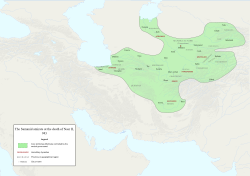
Back الإمبراطورية السامانية Arabic Samánides AST Samanilər Azerbaijani سامانیلر AZB Сәмәниҙәр Bashkir Саманиди Bulgarian সামানি সাম্রাজ্য Bengali/Bangla Samànides Catalan Dinastiyang Samanida CEB سامانییەکان CKB
Samanid Empire سامانیان | |
|---|---|
| 819–999 | |
 Extent of the Samanid realm at the death of Nasr II in 943 | |
| Capital | |
| Common languages | |
| Religion | Sunni Islam (minority Shia Islam, Nestorianism, Zoroastrianism) |
| Government | Hereditary monarchy |
| Amir (Emir) | |
• 819–864/5 | Ahmad ibn Asad |
• 999 | 'Abd al-Malik II |
| Historical era | Middle Ages |
• Established | 819 |
• Disestablished | 999 |
| Area | |
| 928 est.[6][7] | 2,850,000 km2 (1,100,000 sq mi) |
The Samanid Empire (Persian: سامانیان, romanized: Sāmāniyān), also known as the Samanian Empire, Samanid dynasty, Samanid amirate, or simply as the Samanids, was a Persianate Sunni Muslim empire, of Iranian dehqan origin. The empire was centred in Khorasan and Transoxiana; at its greatest extent encompassing Persia and Central Asia, from 819 to 999.
Four brothers—Nuh, Ahmad, Yahya, and Ilyas—founded the Samanid state. Each of them ruled territories under Abbasid suzerainty. In 892, Ismail Samani (892–907) united the Samanid state under one ruler, thus effectively putting an end to the feudal system used by the Samanids. It was also under him that the Samanids became independent of Abbasid authority. However, by 945, the government was under the de facto control of the Turkic military slave faction, and the Samanid family's authority had become purely symbolic.
The Samanid Empire is part of the Iranian Intermezzo, which saw the creation of a Persianate culture and identity that brought Iranian speech and traditions into the fold of the Islamic world. This later contributed to the formation of the Turko-Persian culture.[8]
The Samanids promoted the arts, giving rise to the advancement of science and literature, and thus attracted scholars such as Rudaki, Ferdowsi, and Avicenna. While under Samanid control, Bukhara was a rival to Baghdad in its glory.[9] Scholars note that the Samanids revived Persian language and culture more than the Buyids and the Saffarids while continuing to use Arabic for sciences as well as religious studies. They considered themselves to be descendants of the Sasanian Empire.[10][9] In a famous edict, Samanid authorities declared that "here, in this region, the language is Persian, and the kings of this realm are Persian kings."[9]
- ^ "Persian Prose Literature." World Eras. 2002. HighBeam Research. (September 3, 2012);"Princes, although they were often tutored in Arabic and religious subjects, frequently did not feel as comfortable with the Arabic language and preferred literature in Persian, which was either their mother tongue—as in the case of dynasties such as the Saffarids (861–1003), Samanids (873–1005), and Buyids (945–1055)...". [1]
- ^ Elton L. Daniel, History of Iran, (Greenwood Press, 2001), 74.
- ^ Frye 1975, p. 146.
- ^ Paul Bergne (15 June 2007). The Birth of Tajikistan: National Identity and the Origins of the Republic. I.B.Tauris. pp. 6–. ISBN 978-1-84511-283-7.
- ^ Frye 1975, p. 145.
- ^ Turchin, Peter; Adams, Jonathan M.; Hall, Thomas D (December 2006). "East-West Orientation of Historical Empires". Journal of World-Systems Research. 12 (2): 222. ISSN 1076-156X. Retrieved 12 September 2016.
- ^ Taagepera, Rein (1997). "Expansion and Contraction Patterns of Large Polities: Context for Russia". International Studies Quarterly. 41 (3): 475–504. doi:10.1111/0020-8833.00053. JSTOR 2600793.
- ^ Canfield L., Robert (2002). Turko-Persia in Historical Perspective. Cambridge University Press. p. 12. ISBN 978-0-521-52291-5.
- ^ a b c The History of Iran by Elton L. Daniel, pg. 74
- ^ Frye 1975, p. 145-146.
© MMXXIII Rich X Search. We shall prevail. All rights reserved. Rich X Search